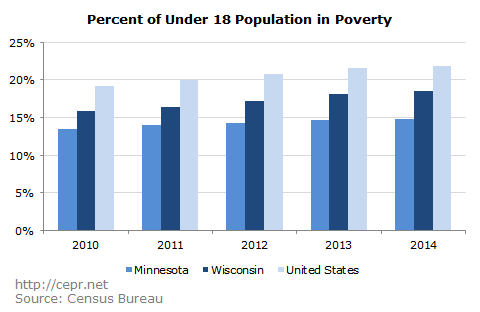July 20, 2016
Tonight, Governor Scott Walker will speak at the GOP Convention supporting his former rival, Donald Trump. As the Governor makes the case for the Republican nominee, it is worth assessing Walker’s record in his more than 5 years in Wisconsin.
During his time as governor, Wisconsin has been a laboratory for many Republican economic policies. Walker cut taxes by more than $4.7 billion, stripped state employees of collective bargaining rights, and deregulated industry. The Republican Party platform calls for similar polices on the national level, making promises to cut taxes and reduce regulatory barriers.
At the same Governor Walker took office in Wisconsin in 2010, Mark Dayton, a liberal Democrat took office in neighboring Minnesota. The relative performances of the two states provide a simple and interesting test of their differing agendas.
Employment Growth
Job creation in Wisconsin has mostly lagged that of Minnesota. At the beginning of Walker and Dayton’s terms in office, their states were creating jobs at a similar rate. In 2011, Minnesota’s job growth outstripped growth in Wisconsin. From 2011 to 2016, employment in Minnesota grew by 8.4 percent compared to only 7.0 percent in Wisconsin. During the time they have been in office, Minnesota has created 39,300 more jobs than Wisconsin, despite having a smaller labor force and population.

Poverty
Policies surrounding poverty have not done well in Wisconsin. The proportion of people living in poverty in Wisconsin has steadily grown from 11.6% when Walker took office to 13.3% in 2014, the last year of data available. In Minnesota, however, poverty grew more slowly, from 10.6% to 11.5%, and held constant from 2013 to 2014.

The difference in child poverty rates is even more striking. The proportion of Wisconsinites under age 18 living in poverty has risen from 15.8% to 18.5%. The increase in child poverty in Wisconsin is twice as large as the increase in Minnesota, 2.7% compared to 1.3%.

Unionization
Walker has been successful in his anti-union policies. While union membership has been on the decline for decades, the proportion of employees who are union members has been cut almost in half during Walker’s tenure. Minnesota has seen more stable rate of unionization, falling gently from 2010 to 2012 before leveling off.

While Walker was pursuing a conservative agenda in Wisconsin, Mark Dayton pursued a classic liberal agenda in Minnesota. Dayton raised the minimum wage and increased the income tax on the top 2 percent of earners to invest in infrastructure and education, among other initiatives. Thus far, these policies appear to be paying off as suggested by the figures above. It is also worth noting that Minneapolis, the state’s largest city, has been touted for being a rare success story in combining high social mobility with affordable urban living.
It is perhaps worth noting that Walker is slated speak on the topic of Hillary Clinton’s email servers on Wednesday instead of on Tuesday night, a night dedicated to the economic agenda of the party.






